What is OTA?
OTA (Over-The-Air in full form) is a wireless technology used to:
- communicate with a SIM card,
- download applications to a SIM card,
- and manage a SIM card
without being connected physically to the card.

In other words: Over-The-Air (OTA) is a technology that updates and changes data in the SIM card without having to reissue it. It is also referred to as Over-the-Air provisioning.
It's both crucial for subscribers and carriers.
Why OTA?
The video below is just an illustration of OTA technology applied to connected cars. It details its benefits.
OTA meaning in automotive: easier recalls, faster access to new features, better security and compliance and lots of savings for car manufacturers.
More broadly, firmware, software updates, and new encryption keys can be downloaded to embedded devices. There are five OTA categories:
- Firmware-over-the-air (FOTA)
- Software over-the-air (SOTA)
- Over-the-air provisioning (OTAP)
- Over-the-air service provisioning (OTASP)
- Over-the-air parameter administration (OTAPA)
How does Over-The-Air work?
OTA enables a Network Operator to introduce new SIM services or remotely modify SIM cards' contents already in the field rapidly and cost-effectively.
OTA is based on client/server architecture where there is an operator back-end system (customer care, billing system, application server ... ), and at the other end, there is a SIM card.
The operator's back-end system sends service requests to an OTA Gateway (or OTA Platform), which transforms them into Short Messages and forwards them onto a Short Message Service Centre (SMSC), transmitting them to one or several SIM cards in the field.
The end-user can receive individual messages from the operator, download or activate new services on their telephone, and much more... without having to return to a retail outlet.
The OTA architecture: 6 components
To implement OTA technology, the following components are needed:
- A back-end system to send requests
- An OTA Gateway to process the requests in an understandable format to the SIM card
- An SMSC to send requests through the wireless network
- A bearer to transport the request: today, it is the SMS bearer.
- Mobile equipment to receive the request and transmit it to the SIM card
- A SIM card to receive and execute the request
Back-end System
The back-end system can be anything from a customer care operator to a billing system, a content provider, or a subscriber web interface.
The provisioning system must be connected to the mobile network (per LAN or via the Internet). Service requests contain the service requested (activate, deactivate, load, modify ...), the subscriber targeted, and the data to perform the service.
The back-end system then sends out service requests to the OTA gateway.
OTA Gateway
The OTA Gateway receives Service-Requests through a Gateway API to indicate the actual card to modify/update/activate.
In fact, inside the OTA Gateway, a card database shows for each card the SIM vendor (e.g., Thales, etc.), the card's identification number, the IMSI, and the MSISDN.
The second step is to format the service request into a message that the recipient's SIM card can understand.
To achieve this, the OTA Gateway has a set of libraries containing the formats to use for each SIM card brand. The OTA Gateway then formats the message differently depending on the recipient card.
The third step consists of sending a formatted message to the SMSC using the right set of parameters described in GSM 03.48. Then the OTA Gateway issues as many SMS as required to fulfil the Service Request. In this step, the OTA Gateway is also responsible for the integrity and security of the process.
SMSC
Services centre for short messages (SMS) exchanged between the management system of these messages (OTA Gateway) and the cellular network.
A message consisting of a maximum of 160 alphanumeric characters can be sent to or from a Mobile Phone. If the Mobile Phone is powered off or has left the coverage area, the message is stored and offered back to the subscriber when the mobile is powered on or has reentered the network's coverage area.
SMS Channel
The communication between the SIM card or eSIM) and the OTA Gateway can be done by SMS exchange and, in this case, named the SMS channel.
Mobile phone
Mobile Phone has all the required features for handling a part or all of standardized GSM services. The Mobile Phone has to be Sim Tool Kit compliant regarding OTA services.
SIM card
Smart cards provide secure user authentication and are mainly used in GSM standards as a Subscriber Identification Module (SIM cards).
The SIM is a significant component of the GSM market, paving the way for value-added services.
SIM cards now offer new menus, prerecorded numbers for speed dialling, and the ability to send pre-formatted short messages (SMS) to query a database or secure transactions.
More resources on OTA update
- M2M and IoT solutions
- OT updates security - Advanced OTA platform: Thales Cloud OTA Platform
- 5G technology
- IoT and FOTA (Firmware Over The Air)
- OTA updates: how does it work? from AnalogDialogue
- Real-time identification and automatic over-the-air configuration (4G)
- OTA and AT&T (2017 PR)
- OTA and MPT (2017 PR)
- OTA and smart meters
- Subscribe to our Corporate Magazine and newsletters